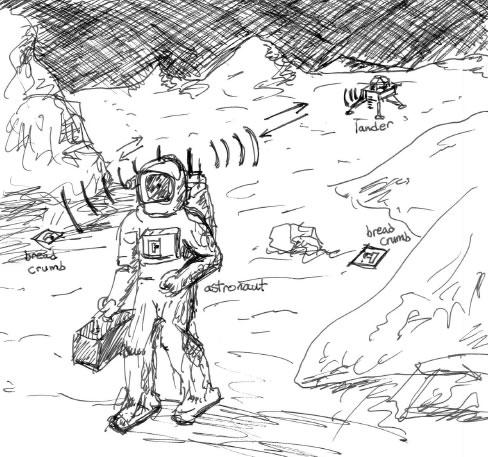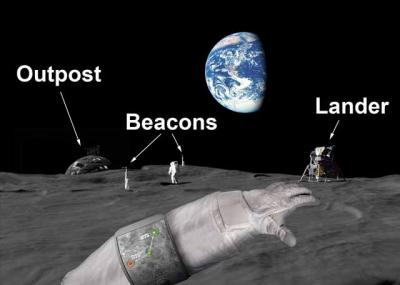| |
TITLE: Lunar Bread Crumbs
TECHNOLOGY AREAS: Space Communications, Radiolocation, Antennas, RF engineering
OBJECTIVE: Design a radiolocation system for astronauts on moonwalk based on the “bread
crumb” concept.
DESCRIPTION: Next decade, the US plans
to return to the moon and perform new
science missions and moon walk
explorations. One of the lessons learned in
previous Apollo missions was the difficulty
in performing rover and astronaut
excursions in the rugged, bright-white
terrain of the moon; it is extremely easy for
astronauts to lose their way in this
featureless environment filled with valleys,
hills, and craters. Earth location systems
such as GPS are not available on the moon
and too costly to build. However, NASA is
extremely interested in testing a new “bread
crumb” technique for tracking astronauts
that travel through regions around their
lunar lander. Much like Hansel and
Gretel’s bread crumbs, an astronaut on
excursion would drop very small, disposable RF identification tags that operate on the principle
of backscatter modulation. The astronaut’s suit would contain a low-powered reader that could
measure reflected tag data and coherent signal strength (amplitude and strength) in proximity of
these tags as well as a signal sent from the lunar lander, using this information to navigate the
lunar terrain.
The company is expected to design the antenna, RF, and communication systems for the landerto-astronaut link and the astronaut-RF tag link, as well as the location algorithm. Several
electrical conditions must be imposed on the system:
All RF tag antennas are presumed to be connected to ideal, passive RF integrated circuits that require -20 dBm of RF power to turn-on. These antennas may be treated as 0 dBi
average-gain isotropic antennas in the analysis and cannot have more than 3% bandwidth.
You must design, build, and measure a prototype omnidirectional transmit antenna for the
lunar lander. Whatever range-measured characteristics this antenna exhibits (gain and
bandwidth), these are the parameters that must be used in the link design for the group’s
project. You may assume that the astronaut-suit-mounted antenna has identical gain and
bandwidth parameters as your lander antenna.
FCC rules do not apply on the moon, so there are no regulatory limits on power and
operating frequency. However, keep radiation safety and power source limitations under
consideration. The frequency of operation must lie between 1-3 GHz.
You must have a data link with at least 100 kbps continual data support from astronaut to
lander (higher rates will make your project more competitive). It must work in non-lineof-sight conditions of up to 2 kilometers, which means that you will have to formulate a
reasonable propagation model for the lunar surface.

The system technical description must include (a) the RF components and modulation for the RF
tag reader and astronaut-to-lander link, (b) an estimate of accuracy for the system, and (c)
operational details of the location algorithm along with any deployment rules or practices that the
moon-walker must follow.
PHASE I: Deliverables include (a) a browse-able, web-based technical report summarizing a
design for the bread-crumb system, (b) measured prototype of an electrically small antenna for
use in the tag. Link budget and location performance statistics in your technical report must be
based on this measured prototype antenna. Competitive rankings will consider 1) cost, 2)
predicted accuracy and performance, and 3) thoroughness and believability in your analysis in
roughly equal proportions.
REFERENCES:
1. T. Pratt, C. Bostian, T. Allnutt, Satellite Communications, 2nd edition, Wiley, 2002.
TPOC: Greg Durgin
Phone: 404-894-2951
Fax: 404-894-5395
Email: durgin @ gatech.edu
|









